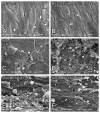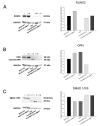Influence of a Physiologically Formed Blood Clot on Pre-Osteoblastic Cells Grown on a BMP-7-Coated Nanoporous Titanium Surface
- PMID: 36975353
- PMCID: PMC10046195
- DOI: 10.3390/biomimetics8010123
Influence of a Physiologically Formed Blood Clot on Pre-Osteoblastic Cells Grown on a BMP-7-Coated Nanoporous Titanium Surface
Abstract
Titanium (Ti) nanotopography modulates the osteogenic response to exogenous bone morphogenetic protein 7 (BMP-7) in vitro, supporting enhanced alkaline phosphatase mRNA expression and activity, as well as higher osteopontin (OPN) mRNA and protein levels. As the biological effects of OPN protein are modulated by its proteolytic cleavage by serum proteases, this in vitro study evaluated the effects on osteogenic cells in the presence of a physiological blood clot previously formed on a BMP-7-coated nanostructured Ti surface obtained by chemical etching (Nano-Ti). Pre-osteoblastic MC3T3-E1 cells were cultured during 5 days on recombinant mouse (rm) BMP-7-coated Nano-Ti after it was implanted in adult female C57BI/6 mouse dorsal dermal tissue for 18 h. Nano-Ti without blood clot or with blood clot at time 0 were used as the controls. The presence of blood clots tended to inhibit the expression of key osteoblast markers, except for Opn, and rmBMP-7 functionalization resulted in a tendency towards relatively greater osteoblastic differentiation, which was corroborated by runt-related transcription factor 2 (RUNX2) amounts. Undetectable levels of OPN and phosphorylated suppressor of mothers against decapentaplegic (SMAD) 1/5/9 were noted in these groups, and the cleaved form of OPN was only detected in the blood clot immediately prior to cell plating. In conclusion, the strategy to mimic in vitro the initial interfacial in vivo events by forming a blood clot on a Ti nanoporous surface resulted in the inhibition of pre-osteoblastic differentiation, which was minimally reverted with an rmBMP-7 coating.
Keywords: BMP-7; blood clot; nanotopography; osteoblast; titanium.
Conflict of interest statement
The authors declare no conflict of interest.
Figures




References
-
- Holmes C., Tabrizian M. Surface Functionalization of Biomaterials. In: Vishwakarma A., Sharpe P., Shi S., Ramalingam M., editors. Stem Cell Biology and Tissue Engineering in Dental Sciences. Academic Press; Cambridge, MA, USA: 2015. pp. 187–206. - DOI
-
- Ferraris S., Cazzola M., Zuardi L.R., de Oliveira P.T. Metal nanoscale systems functionalized with organic compounds. In: Guarino V., Iafisco M., Spriano S., editors. Nanostructured Biomaterials for Regenerative Medicine. Woodhead Publishing; Sawston, UK: 2020. pp. 407–436. (Woodhead Publishing Series in Biomaterials). - DOI
Grants and funding
LinkOut - more resources
Full Text Sources
Research Materials

